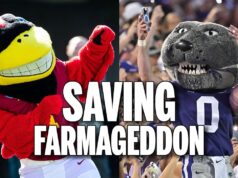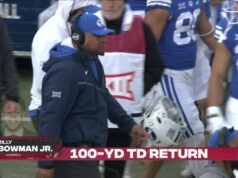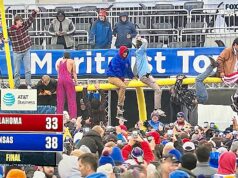
Tears were shed. Cheers were yelled. Hugs were given. Grass was even yanked from the field as mementos of the occasion.
The John Blake era of OU football had finally borne fruit on Oct. 12, 1996, and the throngs of Sooner fans in attendance at the Cotton Bowl in Dallas were ready to welcome it. I was sports editor at The OU Daily student paper, and I watched the exuberant aftermath from the sideline — right near the goalline — when the Sooners defeated the hated and favored Texas Longhorns in overtime. According to some OU fans, it felt as though they had won the last damn football game ever played on the planet.
Thanks to Blake’s positive personality and the Sooners’ surge to success after he departed, the few positive vibes from his head-coach tenure still stand out, even though much of his time as head coach fell short of expectations.
Blake, OU’s football coach from 1996-1999, died Thursday of an apparent heart attack. He was 59. While Blake’s stretch as the Sooners’ gridiron boss ended with a 12-22 career record, there were a handful of successful moments, high points and good feelings during the three-plus years that can’t and shouldn’t be ignored in OU football history.
They simply didn’t last long enough, however. Or, at least long-enough to keep Blake’s reputation as a head football coach from plunging into unescapable depths.
They still happened, however, and should be remembered fondly:
- Dec. 31, 1995: Blake was named head coach — the first Black head coach of any sport in OU history. He proudly stood on the podium in the Santee Lounge at the OU football stadium and proclaimed he was bringing the OU family back together. Following the dysfunction of Howard Schnellenberger’s lone season in 1995, Blake’s statement was music to tradition-loving OU fans’ ears.
- Oct. 12, 1996: The aforementioned game against Texas in the Cotton Bowl is chronicled in the video above. The Sooners had opened the season with four straight losses, only to break out in the most unexpected of ways: toppling a 25th-ranked Texas team, in both programs’ first overtime game no less.
- Nov. 9, 1996: The Sooners avenged a miserable 1995 loss to in-state rival Oklahoma State with a 27-17 victory in Stillwater.
- Sept. 6, 1997: OU defeated a Donovan McNabb-quarterbacked Syracuse team in Norman, 36-34. It was the Sooners’ first home win over a top-25 team since 1993.
- Nov. 22, 1997: The Sooners finished the 1997 season with a surprising 32-21 win at Texas Tech. It was the Red Raiders’ only loss to a Big 12 South Division opponent that season.
- August 1998: The OU football media guide blared “The ‘Bone Is Back!” on its cover to hype the supposed reinstitution of the beloved wishbone offense for the 1998 season. Sooner fans, dreaming of the triple-option bliss of the ‘70s and ‘80s, frothed at the mouth with high anticipation for the season.
- Sept. 12, 1998: A late touchdown, followed by a successful onside kick and a last-second field goal, gave the Sooners an improbable 10-9 win at TCU and a 2-0 start to the season.
The difficult moments
The problem with the Blake era at OU wasn’t a lack of high points — it was how short the euphoria lasted.
For each positive achievement listed above, a disastrous counterpoint exists from 1996 to 1998. Losses ensued at a withering pace under Blake’s tutelage, but at that point at OU, losing — even badly — wasn’t necessarily a stunner or a dealbreaker for Sooner fans. After all, before Blake had even gotten there, OU had suffered through seasons with six wins or fewer in three of the previous four years.
No, the lasting stain on the Blake era was the embarrassing moments that didn’t necessarily occur on the scoreboard. These were the things that quickly brought any elated feelings from the previously mentioned high points plummeting right back down to Earth.
- Using a mat on the sidelines in 1996, with spots numbered one through 11, where players stood before taking the field to make sure the correct number was preparing to participate.
- Successfully kicking a game-tying field goal with seconds left against Kansas in 1997, only to be forced to line up and do it again because of a penalty. The Sooners missed the ensuing kick, losing the game.
- Alternating quarterbacks from play to play against Kansas State in 1997, depending if the situation warranted a running QB or a passing QB.
- The officials agreeing to use a running clock during the second half to hasten the end of a blowout loss against Texas A&M in 1997.
- Pumping up the return of the wishbone as OU’s offense in 1998, only to run just a couple of series from the formation before reverting to a bastardized version of the I-formation, complete with “swinging gate” plays straight out of a 1960s-era playbook.
- Finishing 101st in scoring out of 112 teams in 1998. (The following season, the Sooners finished sixth in scoring under new head coach Bob Stoops and offensive coordinator Mike Leach.)
So, by the time Blake was ushered out of the head coaching position just one day after the last game of the season — a 20-17 win over Texas Tech — OU fans had their fill of a man memorably compared to an under-trained Taco Bell manager by normally understated Oklahoman columnist Berry Tramel.
Still, Blake should be remembered as a good man who brought his share of good moments to the University of Oklahoma football program — moments unfairly forgotten in the shadow of the ensuing low points. Unfortunately for the coach, those emotional plateaus simply didn’t have the lasting power needed to fuel the Sooner program, particularly to the heights coming in the 2000s and beyond.
With John Blake suddenly no longer with us, perhaps OU fans can appreciate the positive memories in a year where we might not have any college football at all.




















